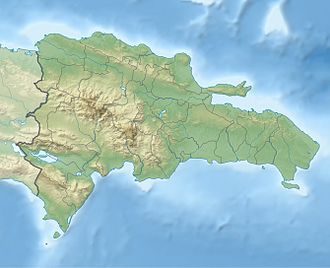Physical oceanography
The Mona Passage connects the Atlantic Ocean waters and Caribbean Sea waters, above a sill depth of 400 to 500 meters (1,300 to 1,600 ft). The sill runs along a northwest to the southeast direction between Cabo Engaño in Hispaniola in the west and the Cabo Rojo Shelf in Puerto Rico to the east margin of the Mona Passage. The vertical profile of the low-frequency (periods longer than 2 days) mean meridional water transport is characterized by a two-layer structure. The upper layer lies above a depth of 300 meters (980 ft), with the upper water masses, the Caribbean Surface Water, Subtropical Underwater and Sargasso Sea Water entering the Caribbean Sea from the Atlantic Ocean. Below this layer, the Tropical Central Water exits toward the Atlantic Ocean. The mean value for the meridional (North-South) transport for a sampled year was –1.85 ± 0.25 sverdrup (Sv) into the Caribbean Sea. [3]
The barotropic tide (surface tide) propagates from northeast to southwest along Mona Passage. The "principal lunar semi-diurnal" constituent, also known as the M2 (or M2), accounts for 52.35% of the total variance observed in the ocean currents, and the semidiurnal current ellipses, with a clockwise rotation, are roughly aligned in a north-south direction. [4]
Semidiurnal tidal currents impinging on a submarine ridge known as El Pichincho can force the generation of an internal tide with a wave height of 40 meters (130 ft). [5] Underwater glider observations reveal wave damping as the internal tide propagates south along the Mona Passage towards the open Caribbean Sea. [6] [7] [8]
Internal tides at El Pichincho can elevate the turbulent vertical diffusivity values (or eddy diffusion), and with a reduction of the Richardson number at the base of the pycnocline. The development of Kelvin-Helmholtz instability during the breaking of the internal tide can explain the formation of high-diffusivity patches that generate a vertical flux of nitrate (NO3−) into the photic zone and can sustain new production locally. [9]
Higher values of primary productivity were observed near the wave trough, than those observed during periods of maximum solar irradiance at noon.
Images from the Moderate-Resolution Imaging Spectroradiometer (MODIS) and International Space Station (ISS) photography show the sea-surface manifestation of packets of internal solitons (or nonlinear internal waves) generated at Banco Engaño, located at the northwest margin of the Mona Passage. [10] [11] The packets propagate either into the Caribbean Sea or the Atlantic Ocean depending on the direction of the currents that forced their generation. [12]
Surface tides, internal tides, internal solitons, inertial currents, and the low-frequency water mass transport between the Atlantic Ocean and the Caribbean Sea make the Mona Passage a very dynamic environment.
This page is based on this
Wikipedia article Text is available under the
CC BY-SA 4.0 license; additional terms may apply.
Images, videos and audio are available under their respective licenses.




